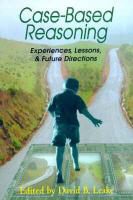Read more
This book presents a selection of recent progress, issues, and directions for the future of case-based reasoning. It includes chapters addressing fundamental issues and approaches in indexing and retrieval, situation assessment and similarity assessment, and in case adaptation. Those chapters provide a "case-based" view of key problems and solutions in context of the tasks for which they were developed. It also presents lessons learned about how to design CBR systems and how to apply them to real-world problems. The final chapters include a perspective on the state of the field and the most important directions for future impact. The case studies presented involve a broad sampling of tasks, such as design, education, legal reasoning, planning, decision support, problem-solving, and knowledge navigation. In addition, they experimentally examine one of the fundamental tenets of CBR, that reasoning from prior experiences improves performance. The chapters also address other issues that, while not restricted to CBR per se, have been vigorously attacked by the CBR community, including creative problem-solving, strategic memory search, and opportunistic retrieval. This volume provides a vision of the present, and a challenge for the future, of case-based reasoning research and applications.
List of contents
CBR in context - the present and future, David B. Leake; a tutorial introduction to case-based reasoning, Janet L. Kolodner and David B. Leake; indexing evaluations of buildings to aid conceptual design, Anna L. Griffith and Eric A. Domeshek; towards more creative case-based design systems, Linda M. Wills and Janet L. Kolodner; retrieving stories for case-based teaching, Robin Burke and Alex Kass; using heuristic search to retrieve cases that support arguments, Edwina L. Rissland et al; a case-based approach to knowledge navigation, Kristian J. Hammond et al; flexible strategy learning using analogical replay of problem solving episodes, Manuela M. Veloso; design a la deja vu - reducing the adaptation overhead, Barry Smyth and Mark T. Keane; multi-plan retrieval and adaptation in an experience-based agent, Aswin Ram and Anthony G. Francis, Jr.; learning to improve case adaptation by introspective reasoning and CBR, David B. Leake et al; systematic evaluation of design decisions in case-based reasoning systems, Juan Carlos Santamaria and Ashwin Ram; the experience sharing architecture - a case study in corporate-wide case-based software quality control, Hiroaki Kitano and Hideo Shimazu; case-based reasoning - expectations and results, William Mark et al; goal-based scenarios - case-based reasoning meets learning by doing, Roger C. Schank; making the implicit explicit - clarifying the principles of case-based reasoning, Janet L. Kolodner; what next? the future of case-based reasoning in postmodern AI, Christopher K. Riesbeck.
Summary
This text presents an introduction and overview of case-based reasoning. It examines the field in a "case-based" way, through concrete examples of how key issues - including indexing and retrieval, case adaptation, evaluation - are being addresed in the context of a range of tasks and domains.

